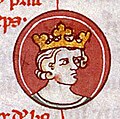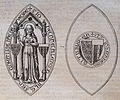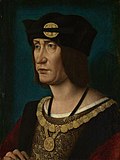| Portrait | Name | Reign | Other titles | Description |
|---|
| Theobald I ,
aka Theobald the Trickster
(c. 910–977) | 940–977 | Count of Tours
Count of Chartres
Count of Châteaudun
Lord of Provins
Lord of Chinon
Lord of Saumur | Son of Theobald the Elder and Richilde. He was a faithful vassal of Hugh the Great which entrusted him with a vast county around 940 including Tours, Blois, Chartres and Châteaudun. He married Countess Luitgarde of Vermandois. During the infancy of Hugh Capet (956–960), Theobald became autonomous and get close to the Carolingian King Lothair II. Theobald enforced many territories or build many fortresses like Vierzon, Sancerre, Chinon, Saumur, Beaugency, and Provins. |
 | Odo I
(c. 950 – died in 996) | 977–996 | Count of Tours
Count of Chartres
Count of Châteaudun
Count of Provins
Count of Reims
Count of Beauvais
Count of Dreux | Second son of Count Theobald I and Luitgarde, he succeeded to his father after his brother's death in Normandy. He attacked Count Bouchard I of Vendôme, a King Hugh Capet's ally, and conquered Melun. He bought his alleagence to the King by giving the county of Dreux to him. He married the Carolingian Bertha of Burgundy. |
 | Theobald II
(c. 983 – 11 July 1004) | 996–1004 | Count of Tours
Count of Chartres
Count of Châteaudun
Count of Provins
Count of Reims
Count of Beauvais | Elder son of Count Odo I, her reign was mainly supervized by his mother, who remarried King Robert II. The King took back Tours from Count Fulk III of Anjou, but Theobald died due to exhaustion on the way back from Rome in 1004, when he was 19. |
 | Odo II
(c. 985 – 15 Nov. 1037) | 1004–1037 | Count of Tours
Count of Chartres
Count of Châteaudun
Count of Provins
Count of Reims
Count of Beauvais
Count of Sancerre
Count of Meaux
Count of Troyes | Younger brother of Count Theobald II, he declared war to all his neighbors, and refused to give back his dowry (half of the county of Dreux) to Duke Richard II of Normandy. He continued to fight against Count Fulk III of Anjou, and finally won against him, but he was defeated in his turn in Pontlevoy by Count Herbert I of Maine. By 1022, he inherited the county of Troyes and Meaux from his cousin, and gathered the Blois-Champagne territory. Since he was also son of Bertha of Burgundy, he claimed his succession rights over the Kingdom of Arles from 1032 onwards, but he was killed next to Bar-le-Duc 5 years later. |
 | Theobald III
(c. 1019 – Sept. 1089) | 1037–1089 | Count of Tours
Count of Chartres
Count of Châteaudun
Count of Provins
Count of Reims
Count of Beauvais
Count of Sancerre
Count of Meaux
Count of Troyes
Lord of Château-Thierry | Elder son of Odo II, who transmitted him the county, but Theobald refused to recognize King Henry I's legitimacy. As a result, the king took the county of Tours back to give it to his ally, Count Geoffrey IV of Anjou, after the battle of Nouy of 1044. He gathered again his father's territories of Blois and Champagne by getting rid of his cousin, Odo, and established Champagne as a proper county. He married Gersent of Le Mans, the daughter of his father's foe. |
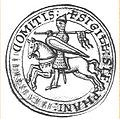 | Stephen
(c. 1045 – died in 1102) | 1089–1102 | Count of Chartres
Count of Châteaudun
Count of Provins
Count of Sancerre
Count of Meaux
Count of Reims | Elder son of Theobald III, he married Adela, daughter of William the Conqueror. Under his wife's influence, he was among the first noblemen in responding to Pope Urban II's call for the First Crusade. With other counts, he fell out of favor when they left the Siege of Antioch, but Count Stephen found a more honorable death at the second battle of Ramla of 1102. His second son was King Stephen of England (1135–1154). |
 | Theobald IV
aka Theobald the Great
(c. 1090/1095 – 10 Jan. 1152) | 1102–1152 | Count of Chartres
Count of Châteaudun
Count of Troyes
Count of Champagne
Lord of Sancerre | First son of Stephen and Adela of Normandy, his reign was managed by his mother until his majority. He faced upheavals from his vassal Hugh III of Le Puiset. When his uncle went to the Holy Land, he inherited the County of Champagne. He was approached by the Norman barons to become king of England, who also called on him to become their duke but, in the end, his brother Stephen was chosen in 1135. Instead, he turned the Champagne into a powerful county, and founded the Champagne fairs. |
 | Theobald V
aka Theobald the Good
(1130 – died in 1191) | 1152–1191 | Count of Chartres
Count of Châteaudun | When his father Theobald IV died, his territories were split between his sons, among which Theobald received the county of Blois and the Champagne was offered to Henry. Theobald tried to conquer Vendôme and took part of Henry the Young King's rebellion to reconquer Tours. He married Alice of France and, as a consequence, entered into the royal family. With his nephew Count Henry II of Champagne, he joined the Third Crusade, but was killed during the Siege of Acre in 1191. |
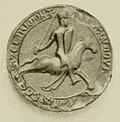 | Louis I
(1171 – 14 April 1205) | 1191–1205 | Count of Chartres
Count of Châteaudun
Duke of Nicaea | Son of Theobald V, whom he beneathed the county from. He married Catherine of Clermont, who was the heiress of the county of Clermont. He was also part of the Fourth Crusade, and was made in 1204 duke of Nicaea, Anatolia. He was killed the following year, during the Battle of Adrianople, on April 14. |
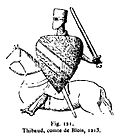 | Theobald VI
(1190–1218) | 1205–1218 | Count of Chartres
Count of Châteaudun
Count of Clermont | Unique son of Count Louis, he inherited both counties of Blois and Clermont. He got leprosy when he travelled to Spain, and died in 1218 while being recluse and having no descendant. The counties of Blois, Chartres, and Châteaudun were split between his aunts, Margaret of Blois and Isabelle of Chartres. |
 | Margaret
(1170 – Sept. 1230) | 1218–1230 | Countess of Châteaudun | Third daughter of Theobald V and Alice of France, she inherited the counties of Blois and Châteaudun when her nephew died. Her husband, Walter II of Avesnes, was the jure uxoris count during her life. |




